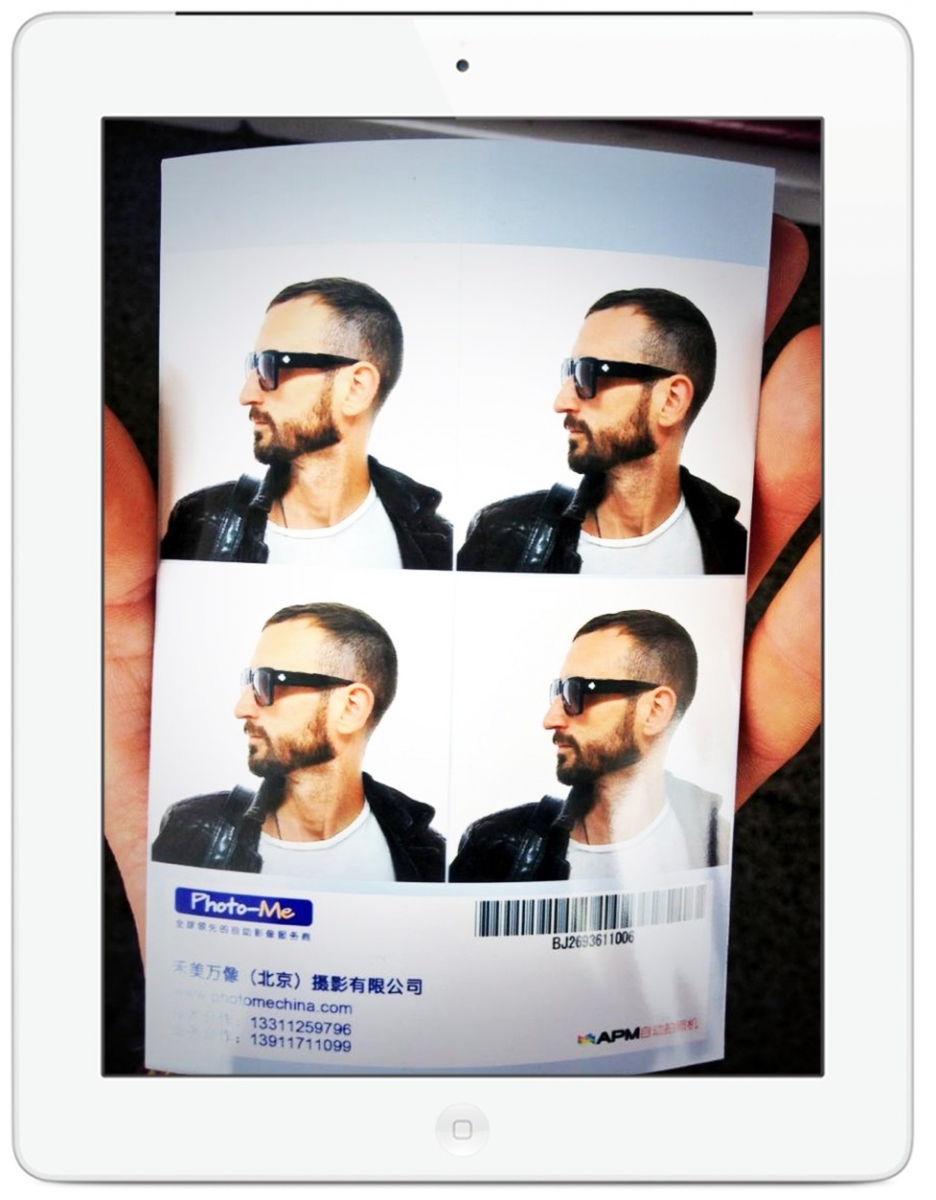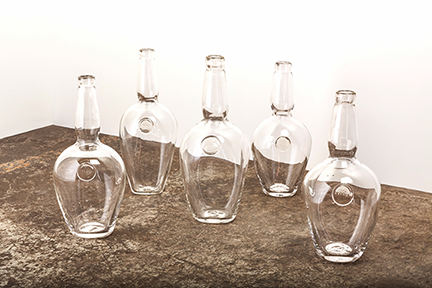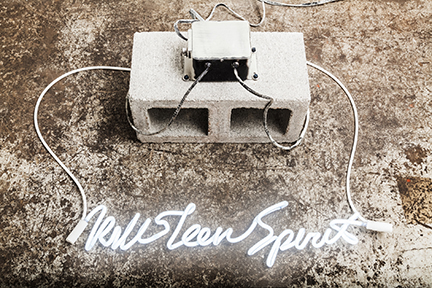
Bradley Rubenstein: I want to talk about your work, but first I want to mention your writing. I totally fucking love your daily, aphoristic pieces. You use Facebook like your own personal Little Red Book. You wrote one about your approach to the art world, I think, but it probably applies to pretty much everything: "If you aren't invited to the table, bring a chair. If they don't serve you, pack lunch. When the bill comes, wash the dishes." It's like a manifesto.
Dylan Neuwirth: Yes, this is this idea. I'm pretty sure it reads like a tweet-length thought, since that's where I spend most of my digital time. I also follow a fair amount of people no one has ever heard of who trade these kinds of thoughts. Within the beautiful limitation of 140 characters we can convey the most perfect idea without the trappings of aesthetics or decoration or the diminutive garbage of class diluting the concepts beyond recognition. Only the pure idea.
I like bringing this to Facebook since it's this perfect black mirror of a world seeking to understand that the social network is indeed the most unsocial activity there is. It is the realm of the un-social -- pure fabrications of our best version of the events we seek to convey, whether it's family, friends, vacations, or cats.
BR: It is interesting how you took Facebook, which was like a blank slate that anyone could publish their ideas on, and usually didn't, and actually started to create a new language -- one in which you are expressing complex thoughts very minimally. Kind of like Joyce, only faster.
DN: For me it's another medium. I treat it like an antagonistic material that seeks to be formed, and so far little has been mutated beyond a constructed front for us to not communicate at all. Twitter is in real time and, in a way, is a visual torrent of thoughts and what is actually happening -- as close as it gets from the real to the digital (whatever that means anymore); whereas Facebook is like the digital cul-de-sac, everyone gathering around while the kids play to brag about going to Mexico and the upcoming wedding. People use Facebook for all kinds of things; my feed is heavy on the artists, innovators, and events I follow. But for me, it's another medium to invent an identity.
Indeed, the table I'm not invited to is this cul-de-sac anyway. There is this place, this table, in whatever echelon, or collection of cliques that are happening, in some scene. For all of my life I've been marginalized for being an outsider. Sometimes I made it this way; other times it was either inferred or overtly made clear to me.
So if they, being they, aren't going to ask you, welcome you, or let you into whatever scene where you seek to make a name for yourself because you believe in yourself and your ideas because you KNOW they have value because you have the confidence to trust yourself, then by all means roll up in there and make yourself known. You already know nothing is going to be free, and you probably can't afford it yet anyway, so stay pumped and bring what you need until you can. For sure they will hate all over you, so give the help, those fellow friends, the night off and even some cash to go see a sick band, and do the work yourself. What is more dope than getting a workout doing those dishes, getting the job done right, and getting to know all the minutiae of the situation going through the trash until you invent a new scene?
That's a bottom-to-top understanding of whatever you're involved in or going after. Inside out. Cell-to-star infiltration. Not even a manifesto, a demand for truth. People ignore the truth. It terrifies them.
BR: It seems to me, looking at Seattle's art scene or world or whatnot, somewhat as an outsider, that there are quite a few artists, like Ian Toms and Robert Yoder, that share a lot with you aesthetically, and maybe some of your DIY attitude, too. Is it fair to put you all together, or are there other people on the West Coast who you identify with -- who you think have the same approach to making art?
DN: I couldn't agree more with you. I had always known about Robert since moving here in 2001. He was this low-pro OG I always knew about but had never met until about six months ago. He sent an email, wanting to hook up and do a studio visit. Through him I got to meet Ian and get exposed to his entire gallery roster at Season.
For me, it was this sick revelation. I felt like, after more than ten years here (but to be real, about seven of those were a disaster of drugs, alcohol, jail, rehabs, destruction, and self-imposed isolation), I had finally connected with those who I COULD connect with and be on the level with, without judgment.
Robert was instrumental in solidifying what I do as an artist -- what I wanted to do without making compromises. He's an incredible artist who does what he wants. His work just emerges. Every piece is a new knife.
Ian is the artist sometimes I wish I was, if I were the same person but did everything completely different. I so get what he does and am jealous as fuck about it and totally love that feeling because it pushes me forward. Flat out, the guy can paint, and paint well. And they aren't just paintings -- they are bits and pieces of a monolithic statement, a total world view that I have a great affinity with.
I mean it's these guys, plus my dudes Jeff Gerber (aka Raven) and Andy Wauman from Berlin, who I identify with. I make art for them, and my longtime girl Rian, and of course my son Bowie. It's my #GANGFAMILY or whatever. If I'm getting off and they're stoked on the work, then that rules. I can't control or construct anything else beyond that because it would be false or diluted.
And I heavily identify with a West Coast view of things -- the LA vibe, the Pacific Northwest dread, the idea of freedom. There's no real collected history here to face or grind against, like the East Coast or the gothic South where I'm from. I've always been drawn to this feeling of complete freedom. As far as shit goes on, figuring that out, certain shout-outs must go to: Mike Kelley, Robert Therrien, Anthony Burdin, Sterling Ruby, and Banks Violette.
That being said, since it's this open vista I'm coming from, I make militant use of social media, since I want nothing more than the work to extend into the outer world to reach new people and forge strong connections where unknown collaborations and ideas can form. Mostly I try to make work that is true and that respects what has, is, and will happen in a global contemporary art world related to economics, culture, and controversy -- the hallmarks of anything worth its idea-weight, anyway.
 BR: I've been spending time over the last couple of weeks looking at your work, and every time I did I had a different take on what you were doing. I wanted to kind of pin it down, get a sight on it, so when we talked I would have some central idea to discuss. It was really a challenge, because every time I thought I had it nailed, I would come up with something new. I think this is the mark of an interesting body of work. In the end I think that the unifying factor is something along the lines of Joseph Beuys's idea of a "social sculpture" -- you are creating things that address a very wide audience, and you want them to become integrated into the culture…
BR: I've been spending time over the last couple of weeks looking at your work, and every time I did I had a different take on what you were doing. I wanted to kind of pin it down, get a sight on it, so when we talked I would have some central idea to discuss. It was really a challenge, because every time I thought I had it nailed, I would come up with something new. I think this is the mark of an interesting body of work. In the end I think that the unifying factor is something along the lines of Joseph Beuys's idea of a "social sculpture" -- you are creating things that address a very wide audience, and you want them to become integrated into the culture…
DN: This is the question I avoid. It's where I want to disappear, here. If I say what the work is, what I do, what I am, it will all dissolve.
The work is about nothing and everything. It's elliptical as I am. Illusions frozen for a moment in time that does not exist and, once given any set meaning, begin to decay as, all agreed, knowledge does. It's: form becomes the content of its undoing.
I make this choice every time I decide something is an object and not going in the trash. The rest is up to everyone else.
I don't consider myself the best of anything, just a purveyor of quality. Meaning, if I can create something that is done right, is quality, then the object has those qualities that make it right -- and job done: image becomes object.
I feel like I'm making a film in slow motion, and each component of the production is in extreme blaring focus. Every scene a new composite layer, creating a final whole whose conclusion is yet to be imagined. It's only something that can be taken as a whole over a great period of time.
I'm not interested in what it all means. I'm just interested in freedom.
At the moment, if I commit to anything beyond the work itself, it all falls apart. I know what I'm doing, and I do it. It's my job, and I just do it.
I think the word is elliptical. It's how I think and talk. Like a web of ideas floating around a central theme. All of my work, in whatever form it takes, is always saying the same thing: I'm alive. I'm experiencing now. You're experiencing now. I do me, you do you, and we do this thing.
The works are residue really -- things I have seen, see, will see, but not quite like what is presented. Like Burroughs, I like to report and let the veil of the journalist cloak me from having to become something I'm not. Although I infuse each discrete entity I'm involved in creating with the essence of myself, I'm not trying to tell anyone anything, or impose or direct their feelings in any true direction, except to feel at all.
More like props, the objects are focal points for conversations that might not happen any other way. They are very much components of a larger social structure created to convey mostly what they aren't presenting. I intentionally leave gaps, or problems, or allow the unexplained to remain, so that what's missing emerges as the work is perceived.
I don't even like talking about art, or talking to other artists about what they do or how they do it. I'd rather talk about what killer music is going on, an unbelievable dinner, films, books, gossip, ideas -- anything that creates content, expressing new images.
The last thing I want to talk about in this way is the work, since I could talk about it for a million unrelenting years or in one elliptical sentence. Each is still an escape act to evade the entropy of giving meaning at all.
Bullshit I've told people when they ask about the work:
I've been a hologram for years.
I'm an illusion in clothes made of mirrors.
I want to give people what they always wanted but didn't know they needed.
The disappearing act is an artist's greatest work.
The illusion of truth is that in time it has meaning.
There was no other option for me. I've tried and failed at everything else there is. Art seemed like the only place where failure was the only option for success.
 BR: Talk a little bit about your sculptural work. I like the things with the neon. Your pieces with neon text are probably the only ones I have seen that I don't think "Bruce Nauman" right away. But you also do the redacted text pieces and other objects too. Is it possible to sum the work up, or is it just that you make an object that has its own discrete existence?
BR: Talk a little bit about your sculptural work. I like the things with the neon. Your pieces with neon text are probably the only ones I have seen that I don't think "Bruce Nauman" right away. But you also do the redacted text pieces and other objects too. Is it possible to sum the work up, or is it just that you make an object that has its own discrete existence?
DN: I actually have a degree in sculpture from the University of Georgia, and object making is not only natural, it's a pivotal part of my process. For me it's the end result of an idea running its course. I have worked with and experiment with so many different high- to low-tech processes that I feel comfortable doing most all of them, but a well-made object (even if it looks shitty on purpose) is always the final destination, and most probably you can see it in many different non-object forms along the way.
It's the ideas of collage culture and sampling; no material or idea is left out until it's distilled down to the ultimate essence or proper cut. Like packing in all that complex information of whatever is going on into a small container, like an infectious pop song. Maximal minimalism. I'm more like a seasoned DJ going to different clubs, feeling the vibe, and choosing what to present that night based on what I'm up to, what's in the current collection, and what the room needs.
For me it's always been that the idea is the object. Nothing more, nothing less. All of my works, in whatever medium I see them in, are like memes of that idea, itself, made into a form. But to do this I have to make each work, in whatever medium, a discrete entity, like you inferred. Each component has to be self-sustaining to create these symbol nets I construct.
This process invariably leads to a collection of work presented as an installation, anchored by a neon work that functions as the focal point. For me, neon is the ultimate alchemy of idea as object. You are literally trapping a gas inside of a glass volume to electrify it so it can convey with light what the form is saying. What a mind fuck. Nothing else does this, and it's dependent on so many things to make it be just right, be that discrete object that sheds the history of its sign industry origins, the weight of Nauman, the quotidian associations of the city.
But it's also these same tropes I seek to exploit when I use it. It's so familiar yet exotic that people can get into it, have some common ground -- that they are open to receive what I'm trying to suggest, illustrate, or intend. If I put most of me into these objects and then you bring even a part of you to the experience, then what's left in the middle is what I think art is. It is an unseen, unknowable, and open-ended thing, like neon itself.
I consider myself a post-human contemporary artist. For me, every idea, work, and resulting body of work in whatever medium is an effort to define an identity in a society of spectacle, consumed by fear, isolation, and doubt, beset by the search for meaning.
